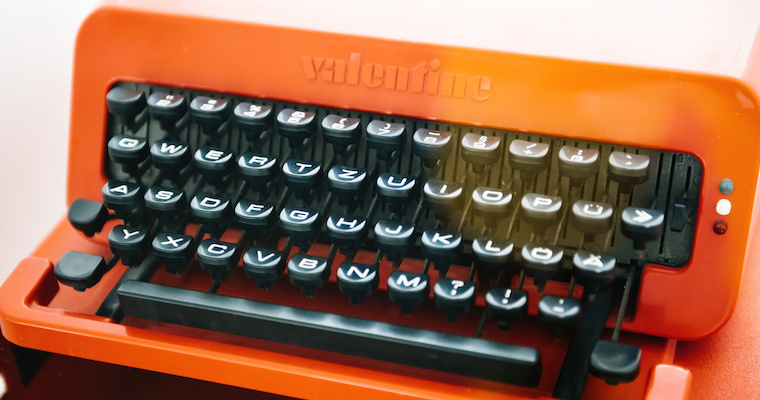What Olivetti Style Teaches Us About Lasting Aesthetic Legacy

Lavazza. Alessi. Olivetti. Campari. These brands evoke images of products, advertisements, or memories of our past: the aroma of Lavazza coffee or an Alessi coffee maker at work, the sound of keys on an Olivetti typewriter, the taste of Spritz.
The family firms behind these storied brands have been successful and popular. Their legacies go beyond wealth, entrepreneurial success or innovation, reputation or brand image. Rather, their legacies involve our senses of touch, sight, sound, taste and smell -- all embedded in our experiences with their most iconic artifacts. These sensory experiences create a timeless aesthetic that links their history with modernity and makes us appreciate their products beyond their functional purpose.
To understand the relationship between businesses and aesthetics, the Center for Family Business Management at the Free University of Bozen-Bolzano has been conducting a study that investigates the processes of how entrepreneurial families develop and build a type of aesthetic, which we call aesthetic legacy, that continues to resonate with their customers over time. Our work included studying the Olivetti family, whose typewriters have become artifacts of many thousands of our personal histories over the decades and whose impact endures today.
As the Olivetti history will show, the legacy of an entrepreneurial family (a family group with a shared vision of value creation that jointly owns and/or manages multiple assets) is a set of enduring meanings tied to a family’s identity. It connects a family to its past and present, shapes innovation and succession, sustains the survival of the family business, and safeguards collective memories. Legacy is shared within the family across generations, and is based on the aesthetics communicated by the family firm through its artifacts.
A Focus on the Subliminal
Previous management research assumes that legacy is recognizable on the basis of codified, transmissible or explicit characteristics (e.g., name, wealth, values, stories, etc.). However, this strand of research has paid less attention to the less obvious, more subliminal factors. We call this "tacit knowledge," a type of knowledge that is personal, intuitive and difficult to express.
Tacit knowledge actively coexists with explicit knowledge in organizations and drives organizational action. One form of this tacit knowledge is organizational aesthetics, which are based on the human capacity for sensory experience and intuitive judgment. Organizational aesthetics, while many people may define them in terms of external beauty, are actually very important to the management of the firm because they can improve its products and services and can create a strong identity that is clearly recognizable to its stakeholders over time. Artifacts such as products, advertisements, buildings or media express the aesthetics of the organization. These artifacts, in turn, become woven into the legacy of an entrepreneurial family.
Our research on aesthetic legacy conducted by the Center for Family Business Management in Bolzano focused specifically on the historical materials, artifacts and images of Olivetti from 1930 to 1969. In an effort to capture the Olivetti style (a recognizable sense of form), we studied the writings of Adriano Olivetti, who designed the famous “Valentine” typewriter, and the buildings of the Ivrea and Pozzuoli headquarters. The results revealed the process through which Olivetti created shared aesthetic schemes, which depicted the organization as a community that is avant-garde and almost a utopian organizational ecosystem -- bringing together artists and technicians, historians and designers, engineers, architects and poets. In "La forza di un sogno," Adriano Olivetti said: "I want Olivetti to be not just a factory but a model, a way of life. I want it to produce freedom and beauty because they will tell us how to be happy.”
The key principle guiding the Olivetti style is the pursuit of service functionality, which emphasizes human needs rather than the rational focus of increasing efficiency. Olivetti’s approach to designing typewriters demonstrates this. Although a typewriter should fulfill its purpose of capturing thought and speech on paper reliably and accurately, it should also be easy for everyone to use. When you look at a Valentine or Letter 22 typewriter you see more than a machine to write with: it's a piece of art, a piece of innovative engineering, and a piece of collective work. While this principle guided product design, Olivetti also applied this humanized approach to managing employees: for example, by offering social services such as health care, housing, maternity leave, etc.
Olivetti’s production site and headquarters in Ivrea, named a World Heritage Site in 2018, are still considered emblematic examples of industrial architecture. These buildings (1st – 3rd extension of the workshops 1934-1949, 4th extension 1957-1959) demonstrate that Olivetti was not dogmatic about its established aesthetics. Instead, Olivetti encouraged and fostered continuous technological, social, cultural and aesthetic development. You can see this in the 4th extension’s architecture: while it still pays homage to the previous extensions, it incorporated the technological, sociological and psychological advancements of its time to address requirements of efficient and flexible production and employees’ needs for natural light and comfortable conditions (e.g., room temperature).
While Ivrea provided enough space to realize Olivetti’s ambitions, the showroom in Venice was challenging because Olivetti’s theme of of modernity and technology had to co-exist with Venice’s historical elegance. Behind the showroom’s big windows, the interior design reflects great attention to material and details. Without enough space for a grand product presentation, like in New York, the products seamlessly fit into the historical environment.
Lessons for Other Families
Leaders of family firms seeking to create an aesthetic legacy must preserve their tacit knowledge and finds ways to pass it down to the next generation. This means expanding the concept of business activity to embody not only strong profits, but also the social, cultural and human development of all employees, and respect for their individual aspirations. Ultimately this will become part of how future generations remember your company and your family.
For instance, the Adriano Olivetti Foundation was founded in 1962, after the sudden and unexpected death of Adriano in 1960, to build and maintain Olivetti’s aesthetic legacy. In 60 years of activity, the Foundation has focused not only onpreserving Adriano’s vision but also using it to guide and inspire entrepreneurs. When Olivetti’s production site in Ivrea became a World Heritage Site in 2018, it brought international recognition of the family legacy and was a turning point for the Foundation. For the future, the Adriano Olivetti Foundation is considering redesigning its mission and vision to focus on technological development and social inclusion. The foundation is managed by Adriano’s grandson, highlighting the family’s active role in initiating, regulating and monitoring the process that continuously builds and shapes the entrepreneurial family’s aesthetic legacy.
Overall, the Olivetti family and the organization emphasized education and culture, through benefits such as educational programs and libraries for employees. But they also involved future generations early in life and imbued them with the family’s humanistic worldview. This has helped them develop and pass down a shared aesthetic understanding of managing the firm. Building this aesthetic legacy can give firms the opportunity to enhance their products and services, therefore serving to improve a firm’s competitive advantage.
As an initial step, we recommend observing and consciously reflecting on whether the firm’s aesthetics meets its purpose. Aesthetics go beyond corporate identity guidelines for internal and external communication. You should also consider your firm’s products and services, how work is performed and processes are set up, and how offices are designed and workstations are organized. The aesthetics of your firm’s philosopy and approach to work and management are even reflected in how you set up events, training sessions for new workers and environments for generating ideas.
Along with inward observation and reflection, you can gain other insights and clarity about your firm’s distinct aesthetics by taking an outward look at how competitors and other iconic firms are perceived and how they actively manage others’ perceptions.
And finally, since aesthetics is an elusive concept that can be difficult to see from the inside, firms looking to build an aesthetic legacy may also benefit from the perspectives of outside observers and advisors.



Professor of Entrepreneurship & Family Business / D’Annunzio University of Chieti-Pescara, IMD Business School and Lancaster University
View Profile





